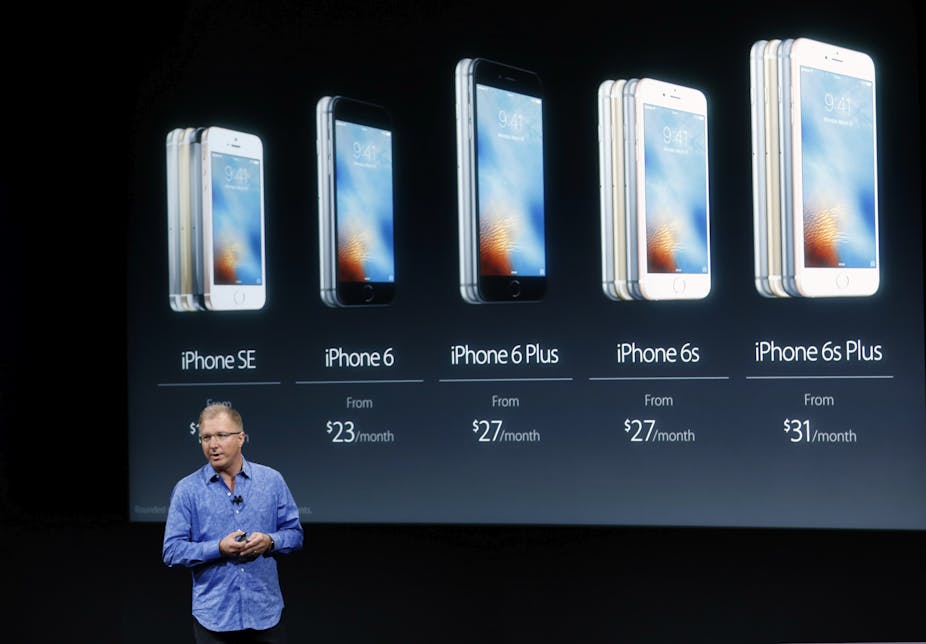Is bigger always better? Not when it’s smaller – and here’s the proof. For the first time, Apple has released an iPhone out of its usual release cycle, one that goes against the trend by arriving smaller and cheaper, targeted at those still using older devices.
In the iPhone SE, Apple has returned to a smaller 4" form factor, but with a modern processor, fingerprint authentication, a 12 megapixel camera capable of astonishing 4K video, and at a lower price point than the larger models. The improved architecture enables the voice-activated digital assistant Siri and Apple Pay, but not the pressure-sensitive 3D display seen in the larger phones. It comes in 16GB and 64GB versions, despite the lack of free space issues that users have encountered attempting to upgrade versions of iOS in the 16GB model.
The traditional smaller 9.7" iPad has been rebranded as the iPad Pro and updated to include features first seen in the larger model Pro last September: a better camera, the latest A9X processor, a smart keyboard cover and most importantly support for the Apple Pencil stylus. This is still rated as the best stylus in the market, and building in support for it will boost sales, particularly in education where the larger Pro may have been regarded as too expensive. Attaching a 4K camera to a tablet may seem counter-intuitive, but judging by the number of people waving them around to take pictures or movies there is a market for it.
Other incremental releases announced in the keynote include iOS 9.3, featuring Night Shift mode which changes the colour of the screen at night to reduce the disruptive effects blue light from screens can have on sleep patterns. There are also various software updates including security enhancements in Notes, extra functionality in News and Health apps, CarPlay and maps improvements. A multi-user mode finally becomes available on the iPad, although its use primarily will be targeted at the education market where iPads are passed from student to student.

Why this, why now?
Why bring out these new devices now? Apple traditionally introduces new iPhone models in the September keynote, with new designs arriving every two years. But in its recent earnings briefing it appeared that iPhone sales will decline for the first time since they were launched in 2007. This should be seen in the context of last year’s record 160m sales, however.
Releasing a smaller phone out of cycle is a play to target the 36% of iPhone owners who have yet to upgrade to the larger sixth generation models, many of whom may be attracted to a model that is smaller than the largest available, but which is nevertheless equipped with the latest features. Similar issues apply to the tablet market: when a tablet does what’s expected of it, users need a significant reason to upgrade from earlier models, and a slightly faster processor or better camera is not sufficient a lure.
It would be easy to follow anti-Apple rhetoric among some commentators that suggests iPads are now outclassed by Microsoft’s latest Surface tablets. Or that iPhone sales are bottoming out due to the ever-increasing quality of cheaper Android phones. Or even that taking on the US government and the current Republican party candidates over security and encryption has run up against the public’s disinterest, and that consumers are more willing to sacrifice privacy in a notional fight against terrorism.
Whether Apple cares about this perception is open to debate, but for the first time the start of the keynote was dominated by issues such as encryption, Apple’s use of renewable energy and the Apple Renew recycling system. This and a focus on the use of data collated through HealthKit suggests an attempt at reinforcing Apple as a company that works to, as Tim Cook put it, “leave the planet better than we found it”.
There are some truths to Apple co-founder Steve Wozniak’s critique that Apple has branched out into the jewellery market where aesthetics trump functionality, seen here with the introduction of yet more Apple Watch wrist straps. But the reality is that despite falling sales, Apple is still making the vast majority of its profits through phones and tablets. Adding to and reinvigorating the number of devices running iOS is important in the long term, as it is this that will fund Apple’s continued push into the living room, the car, health, and the Internet of Things markets where it sees its future.

